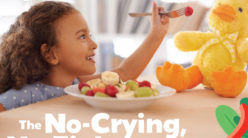One of the most important facts that parents need to understand is this: Children who practice healthy habits early in life are much more likely to continue those habits through their teen years and into adulthood. According to the American Association for Health Education a key reason for that reality is that a child’s brain is more impressionable than an adult’s.
“Young children haven’t had a real opportunity to develop a concrete preference in their likes and dislikes, so it is easier to start them off on the right foot than it is to stop a bad habit later in life,” adds Lawrence Balter, a New York University child psychologist and author. Here are some important habits that parents should begin instilling in their children.
Regular Hand Washing
The simplest way to avoid infection and reduce colds and flu bugs is by routinely and regularly washing hands, say medical experts. The Mayo Clinic notes that while it is impossible to keep hands totally germ-free, there are times when it is critical to wash hands. Children should be taught and reminded to wash at these times:
- Before preparing food, setting the table, or serving food.
- Before eating meals or snacks.
- After visiting a bathroom.
- After sneezing or coughing into their hands.
- After blowing their nose.
- After handling money.
- After playing with a pet.
Mary Sandell, occupational health and epidemiology nurse at Tallahassee Community Hospital, stresses the importance of hand washing, saying: “Organisms enter your body through mucous membranes. Your fingers touch your eyes, nose, and mouth,” which are all points of entry. Most experts agree that the type of soap used is incidental, because the benefit of hand washing is more mechanical than chemical. Any soap and water used acts as a lubricant to loosen up dirt and bacteria on the hands. Thus, when hands are rinsed the debris is rinsed away. In addition, Sandell further cautions parents to remain vigilant about other hygiene issues by reminding children never to put pens or pencils in their mouths: “Think about where those pens have been,” she says. “It’s like putting coins in your mouth.”
Buckle Up
Child safety seats and belts are referred to as the “wonder drugs” when it comes to saving the lives of children. “If seat belts were medicine, they’d be wonder drugs,” says Chuck Hurley, spokesperson for the National Safety Council. “Instead they’re like aspirin–so common that people forget how beneficial they are in preventing death and serious injuries.”
Consider the good fortune of Detroit, Michigan, parents Nikki and Edward Brown. They have buckled their children, ages 1 and 2, into child safety seats since their births, no matter how much they protested. That’s why the Brown toddlers were dangling upside down–but alive–after their sport-utility vehicle rolled over in a potentially fatal crash on one of Detroit’s busy freeways. “The Lord and the child seats saved them,” Nikki Brown says.
Nevertheless, too many parents give in to the complaining and resistance from their children and drive without having them buckled into their seats. Six out of every 10 children killed in crashes are unrestrained by either seat belts or child safety seats. In 1997 an astounding 1,244 of the 2,087 children under age 16 killed in crashes were completely unrestrained.
“It’s a national tragedy, because the majority of children killed in crashes would be alive today if the adults who loved them would have buckled them up properly,” says Janet Dewey, director of the Air Bag and Seat Belt Campaign, a nonprofit group supported by auto makers, insurers, and the federal government. Clearly, auto safety procedures should be followed every time children are in a car or truck regardless of the distance length. Even driving a block down the street warrants strapping on the seat belt or placing a child in a safety seat.
Daily Exercise
Sadly, today’s children are among the most underexercised and overweight youths in the nation’s history. One in five American youths ages 12 to 17 is overweight, according to the National Health and Nutrition Examination Survey (NHANES) conducted by the National Center for Health Statistics. Increasingly, researchers are growing alarmed because childhood obesity has escalated alarmingly in the past decade. In a 1976-1980 NHANES study, the rate of overweight youths was only 15 percent. Today that figure is at 21 percent.
Furthermore, two thirds of our children can’t pass a basic physical fitness test. Forty percent of boys and 70 percent of girls ages 6 to 17 can’t do more than one pull-up. Half the girls and 30 percent of boys can’t run a mile in under 10 minutes. In addition, 40 percent show early signs of heart and circulation problems, according to a recent report by the President’s Council on Physical Fitness and Sports.
An effective way to get children to exercise daily is to turn physical activity into family time. Take walks together after dinner and star gaze. Go for a family bike ride. In the winter, do indoor aerobic workouts together utilizing the many fine workout tapes that are available. Invite the entire family to a roller or ice rink for an evening of skating.
When 6-year-old Renzo Salguero, of Miami, Florida, gets home from school he does his homework, then puts on his running shoes and waits patiently for his father to get home. “They run together almost every day,” says his mother, Bertha. “Renzo gets very excited about it.” Although only in kindergarten, Renzo already has a collection of race trophies and plaques. He’s run a dozen 5Ks, with a best time of 26.33. “His father has to work hard to keep up with him,” says Bertha. “Some days Renzo wants to run twice, but his father says once is enough.”
Healthy Nutrition
For several years the Cancer Research Foundation of America (CRFA) has been issuing a challenge to parents to teach good nutrition to their children, because developing healthy dietary habits in childhood greatly reduces their cancer risk in the future. “Teaching children the ABCs of good nutrition gives them an essential tool for living a healthy life,” notes Oliver Alabaster, director of CRFA. In analyzing foods for cancer risk, he points out, “There is no element in food more damaging than fat.” The CRFA recommends that individuals eat less than 20 percent of calories from fat, or about 30-40 grams per day. However, the average child’s dietary fat is double what it should be (about 36 percent).
To help parents promote lifelong healthy eating habits, CRFA offers these suggestions:
- If using dairy products, switch the family to skim milk, and thereby reduce considerably the amount of fat in a child’s diet.
- Bake or broil, but never fry food. For example, a baked potato is one percent fat, while french fries contain 43 percent fat.
- Make meat a minor player. If at all. Even the leanest meats may contain more than 60 percent of their calories from fat. Use vegetables, grains, and pastas as the centerpiece of the meal.
Proper Safety Equipment
Children love to engage in outdoor activities such as scootering, skateboarding, biking, and in-line skating. In order to prevent injuries and even loss of life, they must be instructed and motivated to wear the proper safety equipment. The most important element of protective gear for such activities is a safety helmet. Scrapes and bruises heal, but head wounds can impact a child for life.
Safety helmets reduce serious head injuries by 88 percent, yet only 15 percent of children under age 15 wear them. It is estimated that the universal use of bike helmets would prevent 135 to 155 deaths annually of children ages four to 15. According to the Bicycle Helmet Safety Institute, a child will wear a helmet if peers and parents do, if a schoolteacher has talked about the importance of the helmet, and if the child has picked out the helmet he or she really wants. Parents should keep in mind that a key motivator of helmet use by kids is fashion, not always safety. Extra money spent on a child’s own selection could be a good investment. Parents should just be certain that the helmet is approved by either the American Society for Testing and Materials (ASTM) or the Snell Memorial Foundation. Look for the approval sticker on the helmet.
Finally, when parents are diligent and disciplined in teaching their children healthy habits, the same parents will experience the delight of watching their children grow up to become fit and healthy adults. Parents will also have the pleasure of seeing that habits they instilled in childhood continue on to last a lifetime.






